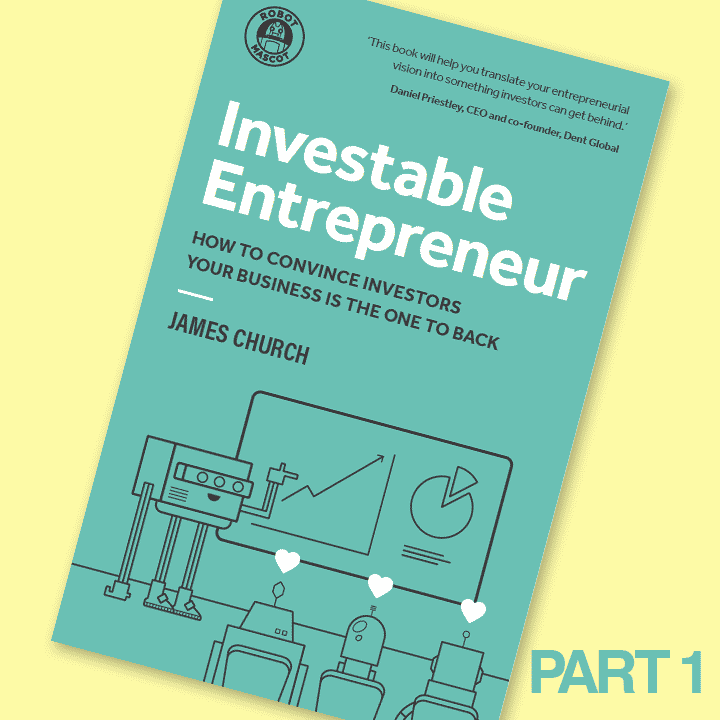Are you an Investable Entrepreneur? Book Interview, Part 1: Preparation
Preparing to Pitch
A new 3 part interview with James Church on his book for founders seeking investment
We got to sit down with James Church, author of Investable Entrepreneur, to find out how you as a founder can create effective pitches, secure funding, and stand out in a saturated, fast-paced market. Digging deeper, you’ll see just how integral strategy and design are to the pitching process and growth of your startup.
We saw parallels between the pitching and branding processes. ‘Investable Entrepreneur’ details the same astute strategic approach as we do at Muneebah Creative.
In this first instalment of the series, we’ll look at why, while preparing for a pitch, it’s critical to know your purpose and vision, as well as the targeted language needed to express yourself effectively to the audience.
FROM GOALS TO GROUNDWORK AND GAPS
Many startups begin with a big goal or lofty dreams. James is no stranger to either as when asked what inspired him to write the book, he too admitted to having a milestone in sight. James uses his own vision for the book to help founders a-like understand the importance of knowing your purpose when pitching.

MW: What inspired you to write the book?
JC: There were many reasons. To begin, I had set myself a personal mission to help a hundred thousand entrepreneurs obtain funding, which is a big, hairy, audacious goal of mine. But I knew it would be impossible to achieve through one-on-one consulting. Writing a book allowed me to develop a real methodology that could reach so many more people and got me one step closer to reaching my goal.
The second reason was, that I noticed in my consultancy we were getting asked the same questions. A lot of the founders weren’t even near ready for investment. I found if I could just say “here, read my book” this would help them get the foundational knowledge they needed.
The first section of the book is about what you need to do prior to actually creating a pitch deck. For example, how to put together a business case for investment. What are the attractions? What are the validations? It is to help you self-identify all the fundamentals. Are you ready to raise investment? How much should you raise? When you should raise it? Getting you to that point where we would actually add some value and work with you.
The last reason was helpful from a ‘running a consultancy’ perspective. The structuring and writing of the book gave me a great opportunity to verbalise and figure out the process we go through to get results and document it. This has enabled us to scale the business because readers can clearly see what we do and come to us for help. It’s also allowed me to ‘pass on the baton’ by training people to adopt parts of this process and methodology.
THE POWER OF PERSPECTIVE
What made James’ book so impactful was how he leveraged being an outsider. In an industry that thrives on outside-of-the-box thinking, James showed how this can benefit your customers when put into practice.

MW: Do you think there’s something missing in other startup books that makes yours unique and stand out?
JC: I think a lot of startup books focus, in part, on fundraising. But they tend to focus on building a product. You think, The Lean Startup, it’s one of those popular books that focus much more on product and the overall business structure of building a startup. There’s not something that necessarily niches down into fundraising quite so hard.
There are some great ones, like Fundraising Field Guide. There are others that do talk about fundraising more broadly from a campaign strategy. I just felt like I had a different take. I think that the secret for me was coming from a brand and advertising background and not a financial one. Lots of books out there, written by investors and individuals with financial backgrounds, do not land very well with entrepreneurs. They’re very technical and speak the language of finance.
What I identified through my research was entrepreneurs speak a different language to investors. I talk about it in my book that Investable Entrepreneurs speak about ideas, opportunities, possibilities, and revenue. Whereas investors speak about risk assets, proof, implementation etc. Having a book about fundraising written by an investor or someone from a finance background wasn’t really resonating with founders. It just wasn’t speaking in their language.

Having come from a brand and marketing background, I realised I could use my skills to help founders raise investment. I could help communicate their business model to investors. This gave me a unique take. Being a founder myself, I too had to learn this stuff from the outside. I could sympathise and relate with other founders. I was trying to figure out what these investors were actually asking for. Through hours of interviews, I’d ask the same questions again and again until I got a simple answer. I then translated that into something everyone could understand.
That, I believe, has been the book’s strength. I’m writing, without a conventional VC background, based on what I’ve learned as a founder.
VISION VS VALUE: GETTING INVESTMENT THROUGH COMMUNICATION
Startup founders get a big idea and run with it, but that may not be enough to inspire investors into action. After James identified communication as the biggest hurdle to gaining investment, he pinpointed that US-based advice can lead UK investors astray but shows how they can get back on track.

MW: Why do you think founders need to speak the investor’s language in order to get investment? Surely big visionary ideas should be inspiring enough?
JC: Great question! You would think a lot of founders put a lot of emphasis on their idea. It’s a great idea so why wouldn’t you invest? What you need to understand is a lot of what we read of the success stories and startup culture is based around what happens in the States. They’ve been doing this much longer than we have in Europe and the UK.
The data suggests that 60% to 70% of American investors come from an entrepreneurial background and they’ve built businesses. They’re using the money made from those businesses to invest in the next generation.
In the States, you can pitch as an entrepreneur to entrepreneurs. They will say “this is a cracking concept and that founder really reminds me of me when I was young. I want to invest in them. I want to back them”.
Whereas in the UK and Europe, it’s the other way. Around 70% to 80% of investors come from financial and corporate banks. They are used to looking at large corporate budgets. They decide where to allocate those budgets to get the best return on investment for that corporate institution. They don’t come from an entrepreneurial background.
UK and European investors look at this on a spreadsheet as cost analysis and risk analysis. Deploying their funds and seeing what the potential returns will be. That mindset completely shifts the approach, particularly for the UK and European founders.
An investor wants to make an informed decision. Founders need to be able to translate their vision into that financial and strategic speak that investors in this region would be looking for.
MW: I see, so it’s a balance of logic and emotion. There’s an emotional aspect in the US whereas, in the UK, it’s much more strategic?
JC: Yes, but there’s also a cultural difference as well. In the US, failure is seen as a badge of honour. It’s seen as a stepping stone to the next big thing. Whereas in the UK, particularly, failure is something that we don’t accept culturally. It’s very difficult to admit that we’ve failed or talk about failure in our culture. US investors are therefore happy to be a bit more eager. Because, for every startup that fails, it means they’re one step closer to finding the unicorn that will succeed.
Whereas in the UK, no one wants to fail. Every single investment decision has a much more conservative approach. For example, looking through the lens of, “this needs to be the right decision because we can’t afford for it to fail”. In the book, I talk a lot about the balance between logic and emotion.

You need to get the investor to buy into your vision. Speak to the heart. Get investors excited about your concept and what you’re trying to achieve. On the flip side, you need to follow that up with detailed information that speaks to the head. Ticking all the logical boxes:
• ‘Have I got the right implementation strategy in place?’
• ‘How am I going to spend my money?’
• ‘Why am I going to spend it in this way?’
• ‘What are my long and short-term stepping stones?’
• ‘What is the financial vision for my company that will deliver the best return on investment for the investors?’
You’ve got to have both sides of that coin when pitching particularly in the UK and the EU. In the US, you also get a much greater result if you take that approach and get investors to buy into the vision in the same way. Instead, rely less on emotion and give them the logic. Then it’s a no-brainer and they love it. They love you. The investor can see you’ve got a clear path to success and to delivering them a return. There’s absolutely no reason for an investor not to invest in your business.
Knowing how to appeal to your customers is crucial for any business. However, knowing the narrative to bring to investors can be the difference between entrepreneurs securing investment or not. James shows how you can get into the mind of investors to turn the tables in your favour.
MW: It sounds like you employ a design thinking approach; solving (end-user) problems — in this case ensuring the investor gets what they’re looking for as well?
JC: Yeah. It’s essential. We treat this like any other marketing campaign. The only difference is that you’re selling shares in your company, not a product. Founders know the problems of their customers inside out. They’ve built a product around those problems. They’re often quite good at pitching that business to those customers and securing deals.
However, they use that same pitch and that same narrative to sell shares to an investor, that doesn’t know the problem. They understand the mind of a target audience, not the potential investor. Therefore their pitch isn’t landing. It’s not ticking the boxes the investors are looking for, the problems they have or the opportunities they want to achieve. It’s not talking to their hopes and dreams.

CONCLUSION
So, in this first part of the series, we spoke about how James Church’s book is assisting founders in preparing to secure investment. We recommend that any budding founder start their journey to getting that next round of funding by downloading a free copy of Investable Entrepreneur.
He touched on some critical factors that are required when developing a pitch strategy. It all comes down to design thinking and speaking the language of your intended audience. This is evident even in the writing of James’ book. The book is successful because he understood who he was talking to and spoke their language.
James teaches it in the context of an investor, whereas we seek to understand our customers in order to gain their attention. If you do not speak to your customer directly, they will switch to another company, just as the investor will. A good entrepreneur will tailor their communication to the appropriate audience so that they feel heard. If you go fishing with the wrong bait you can’t expect to get lucky.
In part 2 of this series, we delve deeper into what you’ve just learned about investors and the value of perspective. You’ll see how to use this preparation to acquire funding in the ‘real’ world of pitching.
—
James’ method is quite similar to how we work at Muneebah Creative; knowing who your target audience is. Using our signature process, Clarity, we develop a brand strategy to ensure long-term success.
Now that you’ve got your investment, if you’re ready to take your startup’s branding to the next stage, get in touch. We’ll help connect your audience to your brand using targeted language in a way that attracts and speaks to them.
“Your brand is the single most important investment you can make in your...
As a Branding consultant for Virgin Startup, I often get questions from...
Does design really impact how your brand is perceived? We break down how...




